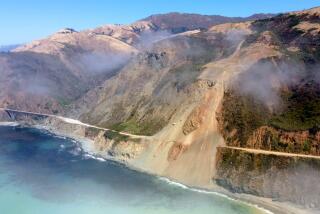The King’s Highway : Road Takes Spanish Turn From San Clemente’s Past
The place on the road is nondescript, like any of a thousand intersections along the highway. An Arco station sits at one corner, directly across from a white beach house near sands populated by surfers and sunbathers.
This is where the city of San Clemente begins. It is also where Pacific Coast Highway ends forever, becoming El Camino Real through the rest of Orange County.
“It’s kind of confusing,” says John Mahabadi, manager of the Arco station marking the southern tip of PCH, which stretches north beyond San Francisco. “People are always coming in and asking for directions.”
The confusion is the direct legacy of one man: Ole Hanson, a developer in the 1920s and the founder of San Clemente. A salesman extraordinaire, Hanson promoted the town--one of the nation’s first planned communities--as a Spanish-style village with white stucco houses, red-tile roofs and streets with names such as “Avenida de Barcelona.” The white stucco and red tile trend has long since faded. But the Spanish names, including the one for PCH, have become a local tradition.
The name El Camino Real, Spanish for “the king’s highway,” stems from the earliest beginnings of what was to become the state’s main coastal thoroughfare.
In 1769, when California was still a Spanish territory, Gen. Gaspar de Portola, accompanied by Father Junipero Serra, led an expedition from Baja California to San Francisco to establish a string of Spanish missions and confirm reports of a huge bay near what is now Monterey. For the next hundred years or so the general route he followed (parts of it were further inland) served as a trail for explorers and settlers named in honor of the king that Portola had served.
As the trail evolved into a highway in the latter 19th and early 20th centuries, it gradually became designated Pacific Coast Highway, Coast Highway or, simply, Highway 1. To this day, however, occasional stretches retain the original designation of El Camino Real due to the whims of local developers.
One of those was Hanson, a Norwegian-born entrepreneur and wealthy real estate broker who came to the United States at an early age, traveled west in 1903, became the mayor of Seattle, and in 1925 purchased much of what now constitutes San Clemente with the idea of creating a new type of city.
“I vision a place where people can live together more pleasantly than in any other place in America,” Hanson, who had toured much of the world including Spain, wrote to a friend in describing his dream. “I am going to build a beautiful city on the ocean where the whole city will be one great park; the architecture will be all of one type, and the homes will be located on sites where nearly everyone will have his wonderful view preserved forever.”
To sell the first lots, Hanson placed ads in the Los Angeles newspapers inviting prospective buyers to come down for a free lunch, lecture and tour of the grounds. It rained on the designated day, causing the developer and his sales team to wonder about the wisdom of their plan. For several hours they waited by the tent in which Hanson was to make his spiel, ankle-deep in mud. Finally the first car rolled up, followed by several more. All told, Hanson fed and spoke to 600 people that day, after which his salesmen chauffeured the would-be settlers around to look at lots. And, miraculously, by day’s end he had sold more than $125,000 worth of land priced at $300 to $1,500 per parcel.
“Hanson was a promoter if ever there was one,” says Charles Ashbaugh, president of the San Clemente Historical Society. “He was a real salesman. He gave a lecture about how great San Clemente was and everybody fell for it, hook, line and sinker.”
The city’s earliest residents had to abide by three strict rules: Their houses had to be built in a Spanish style. They had to be white stucco. And they had to have red-tile roofs.
Hanson personally saw to it that the townspeople obeyed. Once when a woman painted her house brown, Ashbaugh says, the old man knocked on her door and demanded a repainting. When she protested that she couldn’t afford to paint her house again, he made sure that every painter in town showed up at her doorstep early the next morning with paintbrushes in hand to volunteer their services.
The rules were steadfastly enforced until Hanson’s death in 1940. Then various banks, confronted by complaints by would-be builders that red-tile roofs were unsafe and expensive, began lending money on other types of construction. But the Spanish street names remained, continued by succeeding city councils that to this day name new streets in compliance with the tradition.
“I think it’s rather unique and really neat,” says Howard Revie, a local engineer who was a member of the city’s Planning Commission until 1991. “It gives people a sense of community, and the flavor of the community is Spanish. It gets a little difficult when you have new developments, but it works out.”
Thomas Lorch, a City Council member, says: “There’s a character to the community, the charm and quaintness associated with a Spanish village. The Spanish emphasis is something people can relate to.”
Part of that flavor is provided by several public buildings that Hanson built in the town’s original Spanish style and later donated to the city for $1 apiece. One of the best known is the Ole Hanson Beach Club, on Avenida Pico just 1.1 miles south of where PCH becomes El Camino Real. In the minds of many residents, it has come to symbolize the place where PCH ends.
“It’s an important landmark,” says Deborah Reyes, 20, a lifeguard at the beach club, which houses the city’s only Olympic-size pool.
Built in 1930 by Hanson to help lure would-be residents, the club hosted the Olympic swimming tryouts in 1932. Today the complex, a large stucco building with the traditional red-tile roof and the pool in a courtyard, is enjoyed by up to 300 swimmers a day.
“To the people who use it, the pool is vital,” says Dottie Flynn, 75, a regular who is active in the Pool Partnership Committee, a group formed recently to help raise money to keep the beach club open year round. “I don’t think I’d be walking as much without the pool. It’s an important place for the people of San Clemente, a historic (spot) that’s a memento of the city’s beginnings.”
Back up the road at the Arco gas station, where the real landmark should be, there is little talk of important mementos or historic beginnings. Here, at the very site of a profound change in California’s cartography, the conversation centers on the price of gas and how much of it a customer wants. Oh yes, and the confusion caused by the end of a road that’s gone on for more than 600 miles.
“People come here and they get lost,” Mahabadi, the station manager, laments. “Sometimes I draw them a map.”
He pauses before continuing.
“I waste a lot of time drawing maps,” he concludes, shaking his head sadly.
Such is life at the end of PCH.
More to Read
Sign up for Essential California
The most important California stories and recommendations in your inbox every morning.
You may occasionally receive promotional content from the Los Angeles Times.










